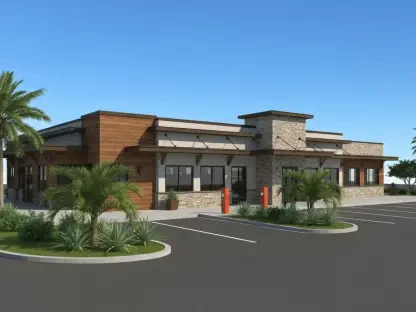In an industry where family dining chains battle fiercely for market share, Mountain Mike’s Pizza has emerged as a standout performer, achieving unprecedented growth and redefining success in the pizza sector. Based in Irvine, California, this beloved brand, known for its crispy, curly pepperonis and massive 20-inch Mountain-sized pizzas, has surpassed 300 locations nationwide, signaling a robust expansion trajectory. This analysis delves into the market dynamics propelling the chain’s rise, examining key trends, data-driven insights, and strategic maneuvers that position it as a leader. With a legacy of over 45 years, the company’s current momentum offers a compelling case study for understanding growth drivers in a saturated market. The following sections unpack the critical elements behind this surge and project potential pathways for sustained dominance.
Decoding Market Trends and Growth Metrics
Expansion as a Core Growth Engine
Mountain Mike’s Pizza has strategically broadened its footprint, opening 11 new restaurants in the first half of the year across emerging markets like Washington, Wisconsin, and Nevada. A landmark moment came with the establishment of its 300th location in Las Vegas, a testament to its accelerating national presence. Beyond this milestone, agreements for 11 additional units pave the way for entry into Virginia and Tennessee, while reinforcing strongholds in California and Colorado. Currently operating over 310 locations across ten states with a development pipeline of more than 120 units, the chain targets a 10% system growth by year-end. This aggressive territorial push into high-demand regions highlights a calculated approach to scaling, balancing risk with opportunity in diverse geographic landscapes.
Customer Engagement Through Innovative Offerings
Another pivotal trend fueling the brand’s market performance is its focus on customer-centric innovation. The introduction of a $9.99 lunch buffet and new salad options, such as Chef’s and Antipasto, caters to value-driven diners and varying dietary preferences. Seasonal promotions have also driven remarkable sales spikes, with initiatives like the Heart-Shaped Pizza boosting Valentine’s Day sales by 35% compared to last year. National Pi Day saw a 43% sales increase, underscoring the impact of targeted campaigns. Additionally, the Mountain Rewards app recorded a 65% membership growth in the second quarter, accompanied by a 52% rise in loyalty sales, pointing to growing digital engagement that enhances customer retention and spending patterns.
Industry Recognition and Competitive Positioning
The chain’s market strength is further validated by significant industry accolades, reflecting its competitive edge over peers. Climbing to #89 on Entrepreneur’s Franchise 500 list and securing the #4 spot in the pizza category, the brand demonstrates consistent appeal to franchisees and consumers alike. Additional honors, such as the Zor Award for “Top Sit-Down Pizza” and “Brand of the Year” by Pizza Marketplace, affirm its operational excellence and marketing prowess. These recognitions not only elevate brand visibility but also attract potential investors, positioning Mountain Mike’s as a top-tier player in a crowded field. Such achievements signal robust market confidence in its business model, setting a benchmark for competitors.
Projections and Emerging Opportunities
Leveraging Digital and Value Trends
Looking toward the next two years, from 2025 to 2027, Mountain Mike’s is well-poised to capitalize on evolving industry trends, particularly the surge in digital ordering and loyalty platforms. The dramatic growth in Mountain Rewards engagement suggests a future where tech-driven convenience will play an even larger role in customer interactions. Economic pressures, such as inflation, may steer more diners toward affordable offerings like the $9.99 buffet, providing an edge over premium-priced competitors. Projections indicate that sustained investment in digital infrastructure could further amplify sales, potentially increasing loyalty transactions by another 20-30% by 2027, assuming current growth rates hold.
Navigating Regulatory and Operational Challenges
While opportunities abound, the brand must also prepare for potential headwinds in the form of regulatory shifts and operational scaling challenges. Changes in labor laws and food safety standards could necessitate adjustments in cost structures and training protocols across its expanding network. Analysts anticipate that family-style chains will need to prioritize agility in operations to maintain consistency, especially as the company eyes additional state entries. Investing in staff development programs, such as the Pizza Legend Program, will be crucial to uphold service quality. Overcoming these hurdles could solidify Mountain Mike’s reputation as an adaptable market leader over the coming years.
Strengthening Community Ties for Long-Term Growth
A less quantifiable but equally vital trend is the growing consumer preference for brands with strong community ties, an area where Mountain Mike’s already excels. Initiatives like Pizza 4 a Purpose, supporting wildfire relief in Los Angeles, and partnerships with local sports teams, such as Angels Baseball, resonate deeply with regional audiences. Market forecasts suggest that localized marketing and philanthropy will become increasingly critical for family dining chains to build trust and loyalty. By doubling down on such efforts, the chain could capture a larger share of consumer sentiment, potentially driving foot traffic and brand affinity in both new and established markets through 2027.
Reflecting on a Milestone Year with Strategic Takeaways
Looking back, Mountain Mike’s Pizza marked a transformative period with record-breaking expansion, innovative customer engagement, and notable industry recognition. The achievement of surpassing 300 locations, coupled with significant sales uplifts from promotions and digital platforms, underscored its market dominance. Strategic moves into untapped regions and a focus on community impact further strengthened its position. For stakeholders, the key takeaway is clear: balancing growth with quality and connection paves the way for success. Moving forward, businesses and franchisees can draw inspiration by prioritizing high-potential markets, investing in technology for customer retention, and fostering local engagement. As the industry evolves, adopting a proactive stance on digital trends and regulatory readiness will be essential to replicate or exceed such remarkable milestones.









